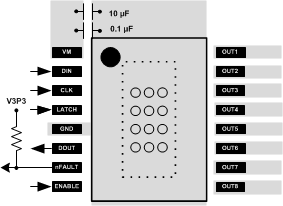SLRS065E September 2013 – November 2015 DRV8860
PRODUCTION DATA.
- 1 Features
- 2 Applications
- 3 Description
- 4 Simplified Schematic
- 5 Revision History
- 6 Pin Configuration and Functions
- 7 Specifications
- 8 Detailed Description
- 9 Application and Implementation
- 10Power Supply Recommendations
- 11Layout
- 12Device and Documentation Support
- 13Mechanical, Packaging, and Orderable Information
パッケージ・オプション
メカニカル・データ(パッケージ|ピン)
サーマルパッド・メカニカル・データ
- PWP|16
発注情報
11 Layout
11.1 Layout Guidelines
- The VM pin should be bypassed to GND using a low-ESR ceramic bypass capacitor with a recommended value of 0.1-μF rated for VM.
- This capacitor should be placed as close as possible to the VM pin on the device with a thick trace or ground plane connection to the device GND pin.
- The VM pin must be bypassed to ground using and appropriate bulk capacitor. This component must be located close to the DRV8860.
11.2 Layout Example
Where the pull-up voltage (V3P3) is an external supply in the range of the recommended operating conditions for the digital open-drain outputs.
 Figure 39. DRV8860 Layout
Figure 39. DRV8860 Layout
11.3 Thermal Consideration
The DRV8860 device has thermal shutdown (TSD) as described in the Thermal Shutdown (TSD) section. If the die temperature exceeds approximately 150°C, the device is disabled until the temperature drops to a safe level.
Any tendency of the device to enter TSD is an indication of either excessive power dissipation, insufficient heatsinking, or too high of an ambient temperature.
11.3.1 Power Dissipation
Power dissipation in the DRV8860 device is dominated by the power dissipated in the output FET resistance, RDS(on). Use the following equation to calculate the estimated average power dissipation of each output when running a driving a load.
where
- PD is the power dissipation of one channel
- RDS(on) is the resistance of each FET
- IO is the RMS output current being applied to each channel
IO is equal to the average current into the channel. Note that at startup, this current is much higher than normal running current; these peak currents and their duration must be also be considered.
The total device dissipation is the power dissipated in each channel added together.
The maximum amount of power that can be dissipated in the device is dependent on ambient temperature and heatsinking.
NOTE
RDS(on) increases with temperature, so as the device heats, the power dissipation increases. This fact must be taken into consideration when sizing the heatsink.
11.3.2 Heatsinking
The PowerPAD package uses an exposed pad to remove heat from the device. For proper operation, this pad must be thermally connected to copper on the PCB to dissipate heat. On a multi-layer PCB with a ground plane, this connection can be accomplished by adding a number of vias to connect the thermal pad to the ground plane.
On PCBs without internal planes, a copper area can be added on either side of the PCB to dissipate heat. If the copper area is on the opposite side of the PCB from the device, thermal vias are used to transfer the heat between top and bottom layers.
For details about how to design the PCB, refer to the TI application report, PowerPAD™ Thermally Enhanced Package (SLMA002), and the TI application brief, PowerPAD Made Easy™ (SLMA004), available at www.ti.com. In general, the more copper area that can be provided, the more power can be dissipated.